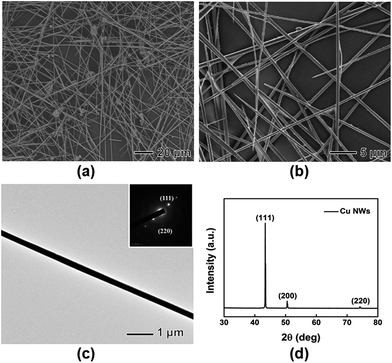Cost-effective aqueous-phase synthesis of long copper nanowires†
Zengmin Tang‡
,
Aasim Shahzad‡,
Woo-Sik Kim* and
Taekyung Yu*
Department of Chemical Engineering, College of Engineering, Kyung Hee University, Youngin, 446-701, Korea. E-mail: wskim@khu.ac.kr; tkyu@khu.ac.kr
First published on 29th September 2015
Abstract
This work describes a simple and aqueous-phase route for the synthesis of Cu nanowires (Cu NWs) having a long length of 140−180 μm, a high aspect ratio of more than 350, and long-term stability. High-quality Cu NWs were synthesized by reduction of CuCl2 with ascorbic acid in the presence of branched polyethyleneimine (BPEI) in an aqueous solution at 90 °C. The synthesized uniform Cu NWs showed long-term stability without the formation of Cu oxides on the surface of the NWs after being stored at room temperature for 40 days. Interestingly, we found that Cl− in the reacting solution played a key role in the formation of long Cu NWs. We also investigated the influence of various experimental conditions including the weight ratio of BPEI/CuCl2, the pH of the reacting solution, and the reaction temperature on the length, morphology, and stability of Cu NWs.
Introduction
Recently, one-dimensional (1D) metal nanostructures have attract interest around the globe due to their potential use in a wide range of advanced applications.1,2 These metal nanostructures are useful for energy conversion, solar cells, touch screens, sensors, and other devices.3 To date, there have been many reports on the syntheses and applications of various 1D metal nanostructures including nanowires,4 nanorods,5 nanobelts,6 and nanotubes.7 Nanowires, which have a high aspect ratio, have emerged as a subject of special interest due to their performance as an essential components in future generations of nanodevices.8,9 Compared with other metal nanowires, copper nanowires (Cu NWs) are the most promising based on their excellent electrical and thermal conductivity.10Recently, various aqueous-phase synthetic methods have been developed for fabrication of Cu NWs, but these methods are not appropriate for large-scale production of high quality long Cu NWs with precise morphological control. For example, methods for synthesizing Cu NWs by adding a reducing agent into an aqueous solution containing a Cu salt and a stabilizer often suffer from short NWs length (below 20 μm), long reaction time (16 h), and complicated procedures.3,11,12 The template method, which typically uses soft and/or hard templates for electrochemical deposition and reduction of copper compounds in the channels of the template, can provide uniform Cu NWs with controllable dimensions.13,14 However, these processes need multiple tedious steps including formation and removal of the templates to obtain Cu NWs. In addition, during the template removal process, the surface of the Cu NWs can be damaged. Moreover, some of the templates are expensive and are composed of toxic materials.15,16 There have been some reports of the synthesis of Cu NWs using amine-based capping agents. Xia and co-workers synthesized Cu NWs using hexadecylamine (HDA).17 However, their synthesis took a very long time (30 h) to complete. Wiley and co-workers also reported the synthesis of Cu NWs using ethylenediamine (EDA) as a capping agent and polyvinylpyrrolidone (PVP) as a stabilizer, however, this synthesis required multiple-steps and the resulting Cu NWs were short (10−20 μm).18 Therefore, developing a simple and economic route for synthesizing high-quality long Cu NWs still remains a significant challenge.
In this work, we describe a simple and aqueous-phase route to the synthesis of Cu NWs with a long length of 140−180 μm, a high aspect ratio of more than 350, and long-term stability. Our simple synthetic protocol involves the reduction of CuCl2 with ascorbic acid in the presence of branched polyethyleneimine (BPEI) in an aqueous-phase at 90 °C. The synthesized uniform Cu NWs showed long-term stability without formation of Cu oxides on the surface of the NWs after being stored at room temperature for 40 days. Interestingly, we found that Cl− in the reacting solution played a key role in the formation of long Cu NWs. We also investigated the influence of various experimental conditions including the weight ratio of BPEI/CuCl2, the pH of the reacting solution, and the reaction temperature on the length, morphology, and stability of Cu NWs.
Experimental section
Materials
BPEI (MW = 750![[thin space (1/6-em)]](https://www.rsc.org/images/entities/char_2009.gif) 000, 50 wt% solution in water), cupric chloride (CuCl2, ≥99%), copper(II) nitrate (Cu(NO3)2), ascorbic acid (C6H8O6, purity ≥99%), sodium hydroxide (NaOH, ≥98%),and nitric acid (HNO3, ∼70%) were purchased from Aldrich and were used without further purification.
000, 50 wt% solution in water), cupric chloride (CuCl2, ≥99%), copper(II) nitrate (Cu(NO3)2), ascorbic acid (C6H8O6, purity ≥99%), sodium hydroxide (NaOH, ≥98%),and nitric acid (HNO3, ∼70%) were purchased from Aldrich and were used without further purification.
Synthesis of Cu NWs
In a typical synthesis, 0.135 g of CuCl2 and 0.04 g of BPEI were dissolved in 2 mL of deionized water in air under magnetic stirring at room temperature. Meanwhile, 3 mL of 0.167 M aqueous ascorbic acid was added to the reaction solution using a micropipette (final volume of the solution was 5 mL and the weight ratio of BPEI/CuCl2 was 0.3). The pH of the resulting solution was 2.9. The resulting mixture was aged at 90 °C for 3 h, and was then cooled down to room temperature. The product was collected by repeated centrifugation and washing with water three times to remove the excess reagents.Characterization
TEM and high-resolution TEM (HRTEM) images were captured using a JEM-2100F microscope operating at 200 kV. Scanning electron microscopy (SEM) images were obtained using a LEO SUPRA 55 microscope. Powder X-ray diffraction (XRD) patterns were obtained using a Rigaku D-MAX/A diffractometer at 35 kV and 35 mA. Fourier transform infrared spectroscopy (FTIR) analysis was performed using a Jasco FTIR-6100 equipped with an ATR assembly in transmission mode. X-ray photoelectron spectroscopy (XPS) data was obtained using a Thermo Scientific K-Alpha spectrometer.Results and discussion
Cu NWs were synthesized by reducing CuCl2 with ascorbic acid in the presence of BPEI in an aqueous-phase at 90 °C for 3 h. After addition of ascorbic acid to the aqueous solution containing CuCl2 and BPEI, the solution gradually changed color from blue to green and finally to dark brownish-red, indicating the reduction of Cu2+ to Cu0 by ascorbic acid (Fig. S1 in ESI†). SEM images shown in Fig. 1(a) and (b) indicate the formation of long and uniform Cu NWs without any post-treatment or separation. The NWs had an average length of 142.14 ± 42.6 μm and an average diameter of 472.9 ± 100.3 nm as calculated from 100 nanowires randomly selected from a number of SEM images (Fig. S2 in ESI†). The Cu NWs exhibited a single-crystal structure, and the growth orientation was along the [011] direction, as can be seen in the selected area electron diffraction (SAED) pattern and HRTEM image (inset of Fig. 1(c) and S3 in ESI†).19,20 Fig. 1(d) shows powder XRD patterns of the NWs, indicating the presence of diffraction peaks at 43.5°, 50.6°, and 74.2°, which can be assigned respectively to the (111), (200), and (220) planes of face-centered cubic (FCC) copper (Fm3m, a = 3.615 Å, Joint Committee on Powder Diffraction Standard or JCPDS file number 04-0836). We did not observe any diffraction peaks of oxide phases such as Cu2O and CuO. XPS was used to probe the formation of Cu2O or CuO layers on the surface of the Cu nanowires. The two strong peaks at 932.8 and 952.6 eV were attributed to Cu 2p3/2and Cu 2p1/2 core levels, confirming the metallic structure of the Cu NWs(Fig. 2(a)). In addition, the XRD patterns of the Cu nanowires stored at room temperature for 40 days still showed only the presence of Cu metal without Cu2O or CuO, indicating the long-term stability of the Cu nanowires (Fig. S4 in ESI†). A FT-IR transmission spectrum of the Cu NWs exhibited distinct peaks at 3420 and 1635 cm−1, which were assigned to stretching and bending modes of amine groups (–N–H). The absorption peaks at 2930 and 1037 cm−1 were assigned to stretching bands of –C–H, and –C–N, respectively, showing the presence of BPEI on the surface of the Cu NWs (Fig. 2(b)). Because BPEI is known as a weak reducing agent, we believe that BPEI prevented the surface oxidation of the Cu NWs.21 We could partially remove the BPEI by several washing the Cu NWs using ethanol. After several washing and storing 40 days at room temperature, we found that thin CuO layer were formed on the surface of NWs. XRD and XPS results show the presence of CuO layer on the surface of NWs while major crystal structure was still metallic Cu (Fig. S5 in ESI†). These results indicate the importance of BPEI for the stability of Cu NWs.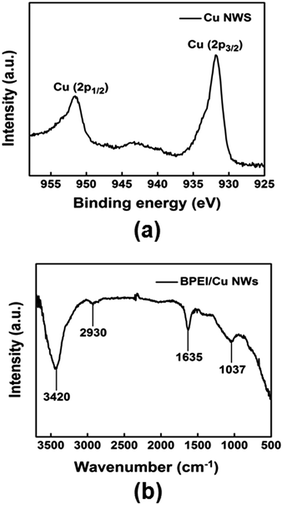 | ||
| Fig. 2 (a) XPS spectra of BPEI-stabilized Cu NWs as shown in Fig. 1. (b) FT-IR spectra of Cu NWs as shown in Fig. 1. | ||
We observed a growth behavior of the Cu NWs by taking samples at various reaction stages and analyzing them by TEM and SEM. Fig. 3 shows TEM and SEM images of the products sampled at 15 min, 20 min, 30 min, and 3 h respectively. At an early stage of t = 15 min, only small Cu nanoparticles with sizes of around 20 nm were synthesized (Fig. 3(a)). At t = 20 min, a TEM image shows the presence of short Cu nanorods with length of 5 μm and diameter of around 400 nm (Fig. 3(b)). As the reaction proceeded to t = 30 min and t = 3 h, the short Cu nanorods started to grow to long nanowires while keeping their diameter of around 400 nm (Fig. 3(c) and (d)). These results suggest that the Cu NWs were grown from small Cu nanoparticles formed at the initial stages of the reaction by addition of monomer attachment without any change in the diameter.
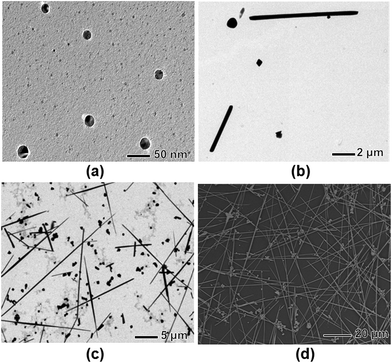 | ||
| Fig. 3 TEM images (a and b) and SEM images (c and d), showing different stages of the growth for Cu NWs. The reaction time was, (a) 15 min, (b) 20 min, (c) 30 min, (d) 3 h. | ||
In reports on the synthesis of metal nanocubes, octahedra, and nanoplates, it has been reported that the selective chemisorption of capping agents such as citric acid and bromide ions reduce the growth rate along the specific direction, thus leading to the formation of nanoparticles with controllable shapes.22 In the present synthesis, we believe chloride ions (Cl−) from CuCl2 can act as a major capping agents for the formation of 1-D structures. When the synthesis was conducted in the presence of Cu(NO3)2 as a precursor instead of CuCl2 while keeping the other experimental conditions unchanged, Cu nanoparticles with cubic and pyramidal shapes were observed as shown in Fig. 4(a). On the other hand, long Cu NWs were observed when the synthesis was conducted in the presence of Cu(NO3)2 and KCl, clearly showing the importance of Cl− in the formation of Cu NWs (Fig. 4(b)).
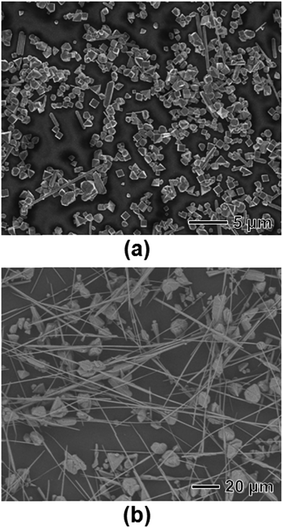 | ||
| Fig. 4 (a) SEM image of a sample prepared under the same conditions as those in Fig. 1 except that synthesis was conducted in the presence of Cu(NO3)2 as a precursor instead of CuCl2. (b) SEM image of a sample prepared under the same conditions as those in Fig. 1 except that synthesis was conducted in the presence of Cu(NO3)2 and an equivalent amount of KCl instead of CuCl2. | ||
In addition to the role of Cl−, we also investigated the effect of the weight ratio of BPEI/CuCl2 on the formation and stabilization of Cu NWs. When the synthesis was conducted in the absence of BPEI (BPEI/CuCl2 weight ratio was 0), a SEM image showed the formation of irregular and aggregated particles (Fig. 5(a)). XRD patterns show that the product was a mixture of Cu and CuCl (F43m, a = 5.405 Å, JCPDS file number 77-2383) instead of pure Cu metal (Fig. 5(b)). This result indicates that BPEI acts as a co-reducing agent for the complete reduction of Cu2+ to Cu metal. At a low weight ratio of 0.1, a small number of short Cu NWs (about 20−80 μm in length)and nanoparticles were produced (Fig. 5(c)). At low weight ratios, there was not enough BPEI to effectively cap the Cu seeds, resulting in the formation of a small portion of Cu NWs. Upon increasing the weight ratio to 0.3, long Cu NW shaving long-term stability were successfully synthesized, as discussed earlier (Fig. 1). At high a BPEI/CuCl2 ratio of 1.2, large particles can be seen with a small number of short Cu NWs (Fig. 5(d)). It would be seem that the formation of a stable BPEI–Cu complex occurred via thermal dynamic growth of Cu nanoparticles, thus limiting the formation and growth of long nanowires.3,23
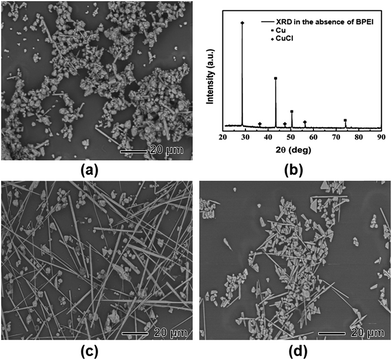 | ||
| Fig. 5 (a) SEM image and (b) XRD patterns of a sample prepared under the same conditions as those in Fig. 1, except that synthesis was conducted in the absence of BPEI. (c and d) SEM images of samples prepared under the same conditions as those in Fig. 1, except that synthesis was conducted at various weight ratios of BPEI/CuCl2: (c) 0.1 and (d) 1.2, respectively. | ||
In an aqueous-phase synthesis, the formation and stabilization of metal nanoparticles are strongly dependent on the pH of the resulting solution.21,24,25 In previous research on the synthesis of Ag nanoparticles using BPEI in an aqueous-phase, we reported that the protonated amine groups of BPEI have a weaker ability to stabilize Ag nanoparticles under strong acidic conditions.21 When the synthesis was conducted under strong acidic conditions (pH = 1.8), thick and short Cu NWs were observed, showing the weak stabilization ability of BPEI (Fig. 6(a)). In contrast, as the pH was increased to 5.3, SEM images showed the formation of large particles (Fig. 6(b)). We believe that increased pH led to the fast reduction rate of Cu2+ by ascorbic acid, which was not favorable for the formation of anisotropic structures.24–26
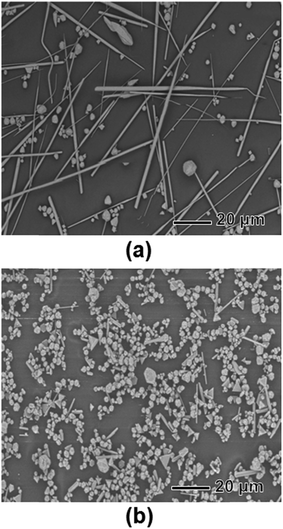 | ||
| Fig. 6 SEM images of Cu NWs prepared under the same conditions as those in Fig. 1, except that synthesis was conducted at different pH values: (a) 1.8 and (b) 5.3, respectively. | ||
The influence of reaction temperature on the formation and growth of Cu NWs was also studied. At low reaction temperatures, the amine groups of BPEI were not sufficiently activated to stabilize the Cu NWs, thus leading to the formation of small and non-uniform Cu NWs (Fig. 7(a)). On the other hand, at a high reaction temperature (100 °C), we observed a large portion of nanoparticles with long Cu NWs in SEM measurements (Fig. 7(b)). These results indicated that temperature was also an important factor for the formation of long Cu NWs.
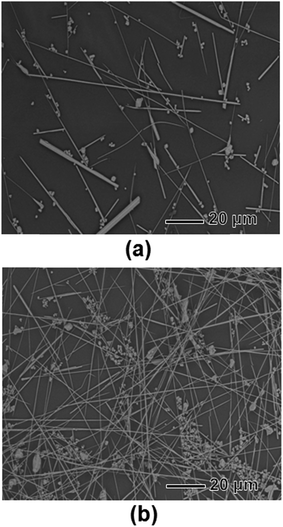 | ||
| Fig. 7 SEM images of Cu NWs prepared under the same conditions as those in Fig. 1, except that synthesis was conducted at various reaction temperatures: (a) 60 and (b) 100 °C, respectively. | ||
Conclusions
We have reported a simple and aqueous-phase route for synthesis of Cu NWs with a long length of 140−180 μm, a high aspect ratio of more than 350, and long-term stability. High-quality Cu NWs were synthesized by reducing CuCl2 with ascorbic acid in the presence of branched polyethyleneimine (BPEI) in an aqueous-phase at 90 °C. The synthesized uniform Cu NWs showed long-term stability without the formation of Cu oxides on the surface of the NWs after being stored at room temperature for 40 days. Interestingly, we found that Cl− in the reacting solution played a key role in the formation of long Cu NWs. We also investigated the influence of various experimental conditions including the weight ratio of BPEI/CuCl2, pH of the reacting solution, and reaction temperature on the length, morphology, and stability of Cu NWs. The employed synthetic route is readily applicable to the large-scale production of long Cu NWs for practical applications due to its simple, fast, and economic reaction conditions. Furthermore, we expect that this synthetic strategy can be extended to large-scale synthesis of other anisotropic metal nanostructures including Pt, Pd, Au, and Ag.Acknowledgements
This research was supported by the Basic Science Research Program through the National Research Foundation of Korea (NRF) funded by the Ministry of Science, ICT & Future Planning (2014R1A5A1009799).This work was also supported by a grant from Kyung Hee University in 2015 (KHU-20150516).References
- A. P. Alivisatos, Science, 1996, 271, 933–937 CAS.
- A. J. Cox, J. G. Louderback and L. A. Bloomfield, Phys. Rev. Lett., 1993, 71, 923–926 CrossRef CAS.
- Y.-Q. Liu, M. Zhang, F.-X. Wang and G.-B. Pan, RSC Adv., 2012, 2, 11235–11237 RSC.
- Y.-J. Han, J. M. Kim and G. D. Stucky, Chem. Mater., 2000, 12, 2068–2069 CrossRef CAS.
- C. Gao, Q. Zhang, Z. Lu and Y. Yin, J. Am. Chem. Soc., 2011, 133, 19706–19709 CrossRef CAS PubMed.
- J. Zhang, J. Du, B. Han, Z. Liu, T. Jiang and Z. Zhang, Angew. Chem., 2006, 118, 1134–1137 CrossRef PubMed.
- T. Kijima, T. Yoshimura, M. Uota, T. Ikeda, D. Fujikawa, S. Mouri and S. Uoyama, Angew. Chem., 2004, 116, 230–234 CrossRef PubMed.
- C. G. Granqvist, Sol. Energy Mater. Sol. Cells, 2007, 91, 1529–1598 CrossRef CAS PubMed.
- L. Gomez de Arco, Y. Zhang, C. W. Schlenker, K. Ryu, M. E. Thompson and C. Zhou, ACS Nano, 2010, 4, 2865–2873 CrossRef CAS PubMed.
- H. Guo, N. Lin, Y. Chen, Z. Wang, Q. Xie, T. Zheng, N. Gao, S. Li, J. Kang, D. Cai and D.-L. Peng, Sci. Rep., 2013, 3, 2323 Search PubMed.
- A. R. Rathmell, S. M. Bergin, Y.-L. Hua, Z.-Y. Li and B. J. Wiley, Adv. Mater., 2010, 22, 3558–3563 CrossRef CAS PubMed.
- H. Wu, L. Hu, M. W. Rowell, D. Kong, J. J. Cha, J. R. McDonough, J. Zhu, Y. Yang, M. D. McGehee and Y. Cui, Nano Lett., 2010, 10, 4242–4248 CrossRef CAS PubMed.
- P. Chen, X. Wu, J. Lin and K. L. Tan, J. Phys. Chem. B, 1999, 103, 4559–4561 CrossRef CAS.
- M. Zhang, S. Lenhert, M. Wang, L. Chi, N. Lu, H. Fuchs and N. B. Ming, Adv. Mater., 2004, 16, 409–413 CrossRef CAS PubMed.
- Y. Xia, P. Yang, Y. Sun, Y. Wu, B. Mayers, B. Gates, Y. Yin, F. Kim and H. Yan, Adv. Mater., 2003, 15, 353–389 CrossRef CAS PubMed.
- X. Sun, S. Dong and E. Wang, Chem. Commun., 2004, 10, 1182–1183 RSC.
- M. Jin, G. He, H. Zhang, J. Zeng, Z. Xie and Y. Xia, Angew. Chem., Int. Ed., 2011, 50, 10560–10564 CrossRef CAS PubMed.
- A. R. Rathmell and B. J. Wiley, Adv. Mater., 2011, 23, 4798–4803 CrossRef CAS PubMed.
- Z. Liu, Y. Yang, J. Liang, Z. Hu, S. Li, S. Peng and Y. Qian, J. Phys. Chem. B, 2003, 107, 12658–12661 CrossRef CAS.
- W. Wang, G. Li and Z. Zhang, J. Cryst. Growth, 2007, 299, 158–164 CrossRef CAS PubMed.
- A. Shahzad, W.-S. Kim and T. Yu, RSC Adv., 2015, 5, 28652–28661 RSC.
- Y. Xia, Y. Xiong, B. Lim and E. Skrabalak, Angew. Chem., Int. Ed., 2009, 48, 60–103 CrossRef CAS PubMed.
- Y. Sun, Y. Yin, B. T. Mayers, T. Herricks and Y. Xia, Chem. Mater., 2002, 14, 4736–4745 CrossRef CAS.
- J. Chen, T. Herricks, M. Geissler and Y. Xia, J. Am. Chem. Soc., 2004, 126, 10854–10855 CrossRef CAS PubMed.
- L. Gou, M. Chipara and J. M. Zaleski, Chem. Mater., 2007, 19, 1755–1760 CrossRef CAS.
- Q. Liu, D. Zhou, K. Nishio, R. Ichino and M. Okido, Mater. Trans., 2010, 51, 1386–1389 CrossRef CAS.
Footnotes |
| † Electronic supplementary information (ESI) available: Additional photograph, TEM image, and XRD result of Cu NWs. See DOI: 10.1039/c5ra15751j |
| ‡ These authors contributed equally to this work. |
| This journal is © The Royal Society of Chemistry 2015 |

